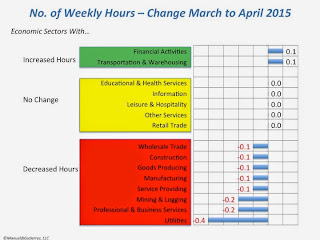 The latest employment report from the Bureau of Labor Statistics brought forth mildly positive news about the state of the U.S. economy, following the disastrous First Quarter results. GDP in the first quarter, as we all know, was barely positive at 0.2%- the statistical margin of error is probably greater than 0.2%! The overall economy remains in a nearly dormant state, with occasional bursts signaling a recovery only to fall back into European-like economic stagnation. Moreover, employment grew an average of 184 thousand new jobs a month in the first quarter, far below the 260 thousand average posted throughout last year.
The latest employment report from the Bureau of Labor Statistics brought forth mildly positive news about the state of the U.S. economy, following the disastrous First Quarter results. GDP in the first quarter, as we all know, was barely positive at 0.2%- the statistical margin of error is probably greater than 0.2%! The overall economy remains in a nearly dormant state, with occasional bursts signaling a recovery only to fall back into European-like economic stagnation. Moreover, employment grew an average of 184 thousand new jobs a month in the first quarter, far below the 260 thousand average posted throughout last year. Thus, the 223 new jobs added in April are an improvement over the first quarter gains, and a particularly welcome one compared to March's measly gain of 84 thousand new jobs. Employment rose in most major economic sectors, with notable exception being Mining & Logging, where employment fell by 15.0 thousand workers. Lower oil prices, as expected, are causing an employment retrenchment in the oil extraction industry. This could be solved if the U.S. Congress fully lifted the ban on oil exports, which will take partial effect in August of this year. Also modest employment declines were observed in Wholesale Trade (-4.5 thousand) and Arts, Entertainment and Recreation (down 2.2 thousand).
Thus, the 223 new jobs added in April are an improvement over the first quarter gains, and a particularly welcome one compared to March's measly gain of 84 thousand new jobs. Employment rose in most major economic sectors, with notable exception being Mining & Logging, where employment fell by 15.0 thousand workers. Lower oil prices, as expected, are causing an employment retrenchment in the oil extraction industry. This could be solved if the U.S. Congress fully lifted the ban on oil exports, which will take partial effect in August of this year. Also modest employment declines were observed in Wholesale Trade (-4.5 thousand) and Arts, Entertainment and Recreation (down 2.2 thousand). On the positive side, large gains were observed in Professional & Business Services, that accounted for over a quarter of the gain with 62 thousand new jobs. Health Care & Social Services, an area whose employment we expect to increase further over the next few years as a result of government subsidies through Obamacare and the demands of aging population, rose by 55.6 thousand workers- also a quarter of April's gain.
Most Gains From Part Time Employment
But it should be noted that virtually all the new jobs created in April were part-time jobs; the number of part-time workers rose by 206 thousand in April, or 92% of the 223 thousand new jobs. The number of persons employed in part-time jobs has remained relatively unchanged since the official end of the 2008 recession, ranging between 26 and 27 million persons.
In fact, as the chart "Part Time Employment" shows, the sharp jump of 3-4 million in the number of part-time workers seen during the recession has not disappeared. It seems like a new plateau in part-time employment has been reached.The transition from part-time to full-time employment has not materialized for most people, assuming that's what many people expect when they get part-time employment.
Mixed Signals From Hours Worked Data
Another statistic that provides a glimpse into the current economic situation is the number of hours that workers put in a week. However, these data do not provide a clear signal. Overall, the number of hours worked in the private sector remained unchanged at 34. 5 a week. But there are sharp differences among the various sectors. The chart "No. of Weekly Hours- Change March to April 2015" identifies those sectors that are either rising or stable, colored in green or yellow, and those that had a decline in the hours worked, shown in red.
What this chart does not show is the fact that for several "goods producing" sectors (e.g., manufacturing, mining, construction), the number of hours worked has been declining for several months. This may help explain partially the country's economic stagnation.
Thus, from the headline numbers one is led to believe that there is a recovery underway. But digging deeper into the data shows still many weaknesses in employment. And, despite the emphasis that many people put in whether GDP is growing or not, the key driver of a robust economy is "solid" employment growth.


I am glad to find your impressive way of writing the post. Thanks for sharing the post.
ReplyDeleteVisit here